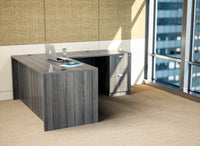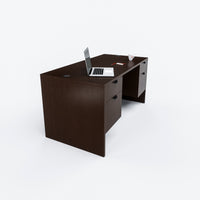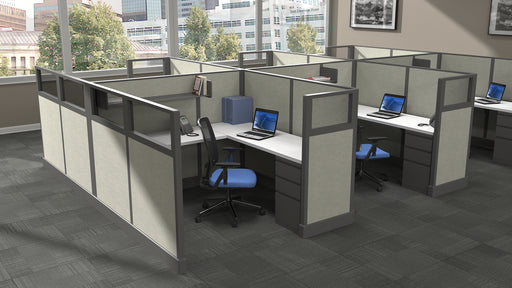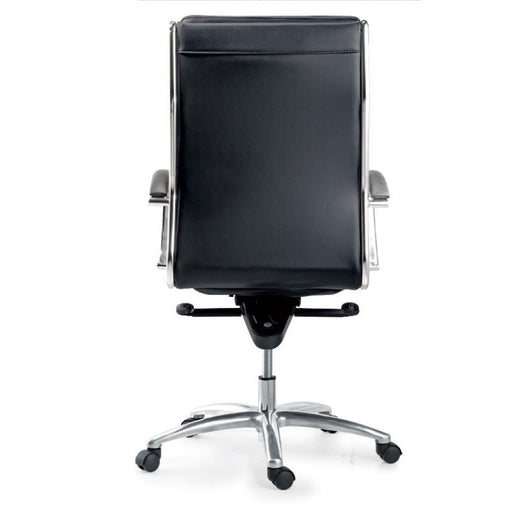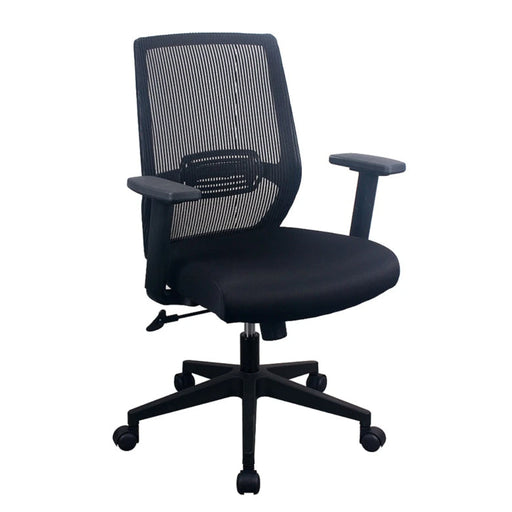-
- Satellite Offices
- Boca Raton
- Miami
- Jacksonville
- Naples
- Sarasota
- Fort Myers
- Gainesville
- Ocala
- Daytona Beach
- Tallahassee
- Hollywood
All Locations -
0

The Right Standard Cubicle Size for Your Office
Whether you're planning to create a series of private workstations or divided collaborative hubs, understanding the intricacies of office cubicles will empower you to fortify a workplace that harmoniously blends the individual needs of employees with the modern demands of a dynamic office space.
In this ultimate guide, we’ll help you determine the right standard office cubicle size for your work environment, helping inform your office planning.
From suggesting how you can organize and decorate office cubicles to listing the essential elements to look out for when purchasing office cubicles, this comprehensive article is packed with everything you need to know about these unique office furniture solutions.
What Exactly are Cubicles?
Office cubicles, or workstations, are segmented spaces within office environments. These modular partitions are designed to provide employees with privacy while being part of large workspaces, encouraging focused work and supporting productivity. Cubicles commonly consist of panels or walls, work surfaces, and storage solutions (such as filing cabinets).
How do you Organize and Decorate a Cubicle?
For an office cubicle to be functional, you must organize it dynamically and conveniently. It's equally important to ensure cubicles are decorated in an inviting and pleasant way, allowing them to boost workplace morale and ensure employee comfort. Here are some key ways you can effectively organize and decorate cubicles in your workplace
- Add Personal Flair: Adding decorative components, such as plants and artwork, will infuse personality into your workplace, creating an aesthetically pleasing setting for employees
- Incorporate Functional Office Equipment: To support employee tasks and aid productivity, ensure you integrate functional accessories, such as desk organizers, keyboard trays, monitor stands, etc.
- Utilize Vertical Space: Install shelving units and cabinets to declutter and free up extra space within cubicles
- Ensure Cable Management: To prevent cords and wires from tangling, use cable management accessories, like cable clips
9 Standard Cubicle Configurations: Forms and Dimensions
When creating modular offices, it's essential to ensure the forms and dimensions of cubicles are equally scaled in line with the required activities and overall available office space. Here are 10 types of standard office cubicle configurations.
1. Standard Cubicle
Standard office cubicles are well-suited to the basic individual needs of employees. These simple yet effective workstations balance privacy with space, offering individuals a designated area for focused tasks while accommodating essential office equipment and providing adequate storage space.
Dimensions
- Width: 48" to 72" | 122 cm to 183 cm
- Length: 48" to 72" | 122 cm to 183 cm
- Area: 16 to 36 ft2 | 1.45 to 3.34 m2
2. Administrative Cubicle
Administrative cubicles accommodate the needs of mid-level employees, who require additional privacy, sufficient storage space, and potential capacity for casual interactions between visitors and co-workers, such as face-to-face discussions.
Dimensions
- Width: 72" | 183 cm
- Length: 96" | 244 cm
- Area: 48 ft2 | 4.5 m2
3. Executive Workstation Cubicle
Executive workstations are the largest type of cubicle. They provide upper-level employees with enough space to host small meetings while accommodating office equipment and additional storage space.
Dimensions
- Width: 120" | 305 cm
- Length: 144" | 366 cm
- Area: 120 ft2 | 11.1 m2
4. Call Center Cubicle
Call center cubicles, or utility cubicles, are simplistic yet efficient workstations. Their compact size makes them exceptionally space-effective and ideal for workspaces with a large number of employees.
Because of their compact size, call center cubicles are commonly arranged linearly in rows. These cubicles are best suited to employees with minimal office equipment who don't require large desk surfaces.
Dimensions
- Width: 24" | 61 cm
- Length: 48" | 122 cm
- Area: 16 ft2 | 1.5 m2

5. L-shaped Management Workstation Cubicle
L-shaped management cubicles provide managerial employees with optimized space and increased privacy. Due to their L-shape desk plan, these unique workstations offer the optimal space needed for independent tasks while being easy to arrange within an office floor plan, thanks to their square modular layout.
Dimensions
- Width: 96" | 244 cm
- Length: 96" | 244 cm
- Area: 64 ft2 | 5.9 m2
6. Management Workstation Cubicle
Management workstation cubicles offer a generous amount of space while simultaneously upholding privacy. These cubicles function much like traditional private offices, allowing managerial employees to perform tasks privately and host small meetings with guests and teammates.
Dimensions
- Width: 96" | 244 cm
- Length: 144" | 366 cm
- Area: 96 ft2 | 8.9 m2
7. Task Workstation Cubicle
Task workstations are popular cubicles that provide employees with an equal balance of privacy and space. These cubicles boast square modular dimensions, making them ideal workstations when laying out an entire office floor plan.
Dimensions
- Width: 72" | 183 cm
- Length: 72" | 183 cm
- Area: 36 ft2 | 3.3 m2
8. U-shape Management Workstation Cubicle
U-shape management cubicles act as private spaces for managerial employees. These workspaces present increased space for mobility, storage, and work surfaces, offering individuals enhanced flexibility.
Dimensions
- Width: 96" | 244 cm
- Length: 96" | 244 cm
- Area: 64 ft2 | 5.9 m2
9. Utility Task Workstation Cubicle
Utility task workstation cubicles provide more privacy and space than standard or call center cubicles. These workstations provide additional surface space for office equipment while offering individualized workspaces connected to a larger office environment.
Dimensions
- Width: 48" | 122 cm
- Length: 72" | 183 cm
- Area: 24 ft2 | 2.2 m2
* Please note: Specific dimensions of cubicles will differ depending on the manufacturer and intended usage. All dimensions detailed above are intended to offer you a rough guide.
What Office Cubicle Size is Right for Your Floor Plan?
Unsure of which cubicle size is best for your floor plan? Don't fret! Here are some different cubicle configurations.
5 x 5 Office Cubicles
5 x 5 cubicles maximize space efficiency, making them ideal for open-plan office spaces. They also invite openness, offering employees a dynamic, collaborative workspace while maintaining basic privacy.
6 x 6 Office Cubicles
Ideal for compact office layouts, 6 x 6 cubicles balance privacy and interaction. These cubicles are ideal for businesses with small- to medium-sized teams, creating a hub where employees can interact and focus.
7 x 7 Office Cubicles
Well-suited to mid-sized office floor plans, 7 x 7 cubicles present more personal room for each employee, offering efficient space utilization for various activities, storage, and equipment.
8 x 8 Office Cubicles
8 x 8 cubicles are suited to spacious office floor plans. These sizable workstations offer ample space for employees and teams needing more room for dedicated tasks, storage, and equipment.
What to Look for in a Cubicle?
To ensure you select the right cubicle for your workspace, it's important to consider the following essential elements when choosing a cubicle.
Shape and Size
Ensure your chosen cubicle's size and shape align with your employees’ needs. A suitable cubicle should provide sufficient space, privacy, storage, and comfort for the intended tasks.
Style and Color
Choose a style and color that complement the overall interior aesthetic of your office. This will ensure your workplace is cohesive and visually pleasing.
Height
Main office cubicle heights vary, with common office cubicle heights ranging between 39 and 67 inches (3.25 to 5.58 feet) and even going up to 85” (7.08 feet). The height you need depends on factors such as visibility, privacy, and collaboration.
For instance, cubicles with lower panels will encourage collaboration between employees, whereas taller panels offer seclusion. When choosing an appropriate panel height, consider the activities your cubicle will be used for to ensure its specifications align with the atmosphere you intend to create.
Timeline Constraints
It's important to consider your project timeline when choosing a cubicle. For instance, if you are pressed for time, it's likely best to opt for cubicles that can be installed quickly to ensure you meet your required deadline.
Panels/Partitions
Panels come in many forms, including glass, laminate, and fabric. Consider the type of panels you want to separate cubicles from each other to ensure your office strikes a desired balance between privacy, collaboration, and aesthetics.
Team Usage and Size
Cubicles need to accommodate the individual needs of employees, such as mobility and collaborative needs. Evaluating the intended uses and size of teams will help you choose the right cubicles to support various uses.
Workstation Space
To remain functional, cubicles need to be sufficiently sized in order to maintain an organized space that accommodates storage and necessary office equipment. Measuring and understanding the minimum required space of cubicles will help you refine your search and ensure you invest in the perfect-sized workstations.
Budgetary Needs
To ensure you don't overspend, always uphold your budgetary needs when shopping for cubicles. This will enable you to refine your search to your available price range while ensuring you purchase cubicles with the necessary features.
Conclusions
By tailoring the cubicle dimensions to the specific needs of your workforce while simultaneously aligning to your office's floor plan, you will successfully fortify a productive and harmonious workspace that balances functionality, employee comfort, and privacy.

